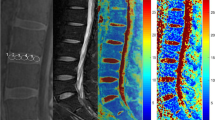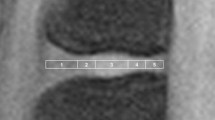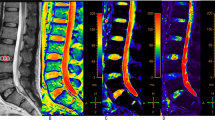Abstract
Objective
To determine the relative performance of T1rho and T2 relaxation times in disc degeneration assessment.
Methods
Lumbar sagittal MRI was performed at 3 T in 52 subjects. With a spin-lock frequency of 500 Hz, T1rho was measured using a rotary echo spin-lock pulse embedded in a three-dimensional (3D) balanced fast field echo sequence. A multi-echo TSE sequence was used for T2 mapping. Regions of interest (ROIs) were drawn over the T1rho and T2 maps, including nucleus pulposus (NP) and annulus fibrosus (AF). Eight- and five-level disc degeneration semi-quantitative grading was performed.
Results
For NP, T1rho and T2 decreased quadratically with disc degeneration grades and had no significant trend difference (P = 0.40). For AF, T1rho decreased linearly as the disc degenerated and had a slope of −3.02 and −4.56 for eight- and five-level gradings respectively; while the slopes for T2 values were −1.43 and −1.84 respectively, being significantly flatter than those of T1rho (P < 0.001). There was no significant difference in T1rho and T2 values for both NP and AF among discs of grade 5/8 to 8/8 degeneration.
Conclusion
T1rho is better suited for evaluating AF in degenerated disc than T2. In NP, T1rho and T2 decrease in a similar pattern following disc degeneration.
Key Points
• MRI provides unique information about the lumbar disc nucleus pulposus
• Both T1rho and T2 relaxation times decrease similarly following disc degeneration
• AF T1rho relaxation times decrease progressively faster than T2 relaxation times
• T2 and T1rho relaxation times do not reduce further by disc-space narrowing





Similar content being viewed by others
Abbreviations
- AF:
-
Annulus fibrosus
- NP:
-
Nucleus pulposus
References
Adams MA, Roughley PJ (2006) What is intervertebral disc degeneration, and what causes it? Spine 31:2151–2161
Modic MT, Ross JS (2007) Lumbar degenerative disk disease. Radiology 245:43–61
Pfirrmann CW, Metzdorf A, Zanetti M, Hodler J, Boos N (2001) Magnetic resonance classification of lumbar intervertebral disc degeneration. Spine 26:1873–1878
Griffith JF, Wang YX, Antonio GE, Choi KC, Yu A, Ahuja AT, Leung PC (2007) Modified Pfirrmann grading system for lumbar intervertebral disc degeneration in elderly subjects. Spine 32:E708–E712
Wang YX, Griffith JF, Ma HT, Kwok AWL, Leung JCS, Yeung DW, Ahuja AT, Leung PC (2011) Relationship between lumbar bone mineral density and disc degeneration: cross-sectional study in elderly subjects suing an 8-level disc degeneration grading system. Osteoporos Int 22:91–96
Wang YX, Kwok AW, Griffith JF, Leung JC, Ma MT, Ahuja AT, Leung PC (2011) Relationship between hip bone mineral density and lumbar disc degeneration: a study in elderly subjects using an 8-level MRI based disc degeneration grading system. J Magn Reson Imaging 33:916–920
Phillips FM, An H, Kang JD, Boden SD, Weinstein J (2003) Biologic treatment for intervertebral disc degeneration: summary statement. Spine 28:S99
Vadalà G, Sowa GA, Kang JD (2007) Gene therapy for disc degeneration. Expert Opin Biol Ther 7:185–196
Carl A, Ledet E, Yuan H, Sharan A (2004) New developments in nucleus pulposus replacement technology. Spine J 4:325S–329S
Weidenbaum M, Foster RJ, Best BA, Saed-Nejad F, Nickoloff E, Newhouse J, Ratcliffe A, Mow VC (1992) Correlating magnetic resonance imaging with the biochemical content of the normal human intervertebral disc. J Orthop Res 10:552–561
Kerttula L, Kurunlahti M, Jauhiainen J, Koivula A, Oikarinen J, Tervonen O (2001) Apparent diffusion coefficients and T2 relaxation time measurements to evaluate disc degeneration: a quantitative MR study of young patients with previous vertebral fracture. Acta Radiol 42:585–591
Perry J, Haughton V, Anderson PA, Wu Y, Fine J, Mistretta C (2006) The value of T2 relaxation times to characterize lumbar intervertebral discs: preliminary results. AJNR Am J Neuroradiol 27:337–342
Chiu EJ, Newitt DC, Segal MR, Hu SS, Lotz JC, Majumdar S (2001) Magnetic resonance imaging measurement of relaxation and water diffusion in the human lumbar intervertebral disc under compression in vitro. Spine 26:E437–E444
Johannessen W, Auerbach J, Wheaton AJ, Kurji A, Reddy R, Borthakur A, Elliott DM (2006) Assessment of human disc degeneration and proteoglycan content using T1rho MRI. Spine 31:1253–1257
Blumenkrantz G, Li X, Han ET, Newitt DC, Crane JC, Link TM, Majumdar S (2006) A feasibility study of in vivo T1rho imaging of the intervertebral disc. Magn Reson Imaging 24:1001–1007
Auerbach JD, Johannessen W, Borthakur A, Wheaton AJ, Dolinskas CA, Balderston RA, Reddy R, Elliott DM (2006) In vivo quantification of human lumbar disc degeneration using T(1rho)-weighted magnetic resonance imaging. Eur Spine J 15:338–344
Blumenkrantz G, Zuo J, Li X, Kornak J, Link TM, Majumdar S (2010) In vivo 3.0-tesla magnetic resonance T1rho and T2 relaxation mapping in subjects with intervertebral disc degeneration and clinical symptoms. Magn Reson Med 63:1193–1200
Charagundla SR, Borthakur A, Leigh JS, Reddy R (2003) Artifacts in T(1rho)-weighted imaging: correction with a self-compensating spin-locking pulse. J Magn Reson 162:113–121
Li X, Han ET, Busse RF, Majumdar S (2008) In vivo T(1rho) mapping in cartilage using 3D magnetization-prepared angle-modulated partitioned k-space spoiled gradient echo snapshots (3D MAPSS). Magn Reson Med 59:298–307
Wang YX, Yuan J, Chu E, Huang H, Go MY, Ahuja AT, Sung JJ, Yu J (2011) Magnetic resonance T1rho imaging is sensitive to evaluate liver fibrosis: an experimental study in rat biliary duct ligation model. Radiology 259:712–719
Nguyen AM, Johannessen W, Yoder JH, Wheaton AJ, Vresilovic EJ, Borthakur A, Elliott DM (2008) Noninvasive quantification of human nucleus pulposus pressure with use of T1rho-weighted magnetic resonance imaging. J Bone Joint Surg Am 90:796–802
Marinelli NL, Haughton VM, Muñoz A, Anderson PA (2009) T2 relaxation times of intervertebral disc tissue correlated with water content and proteoglycan content. Spine 34:520–524
Krueger EC, Perry JO, Wu Y, Haughton VM (2007) Changes in T2 relaxation times associated with maturation of the human intervertebral disk. AJNR Am J Neuroradiol 28:1237–1241
Akella SV, Regatte RR, Gougoutas AJ, Borthakur A, Shapiro EM, Kneeland JB, Leigh JS, Reddy R (2001) Proteoglycan induced changes in T1 ρ-relaxation of articular cartilage at 4T. Magn Reson Med 46:419–423
Cassinelli EH, Hall RA, Kang JD (2001) Biochemistry of intervertebral disc degeneration and the potential for gene therapy applications. Spine J 1:205–214
Antoniou J, Steffen T, Nelson F, Winterbottom N, Hollander AP, Poole RA, Aebi M, Alini M (1996) The human lumbar intervertebral disc: evidence for changes in the biosynthesis and denaturation of the extracellular matrix with growth, maturation, ageing, and degeneration. J Clin Invest 98:996–1003
Wang YX (2005) Medical imaging in pharmaceutical clinical trials: what radiologists should know. Clin Radiol 60:1051–1057
Wang YX, Griffith JF (2010) Effect of menopause on lumbar disc degeneration: potential etiology. Radiology 257:318–320
Videman T, Battie MC, Gibbons LE, Maravilla K, Manninen H, Kaprio J (2003) Associations between back pain history and lumbar MRI findings. Spine 28:582–588
Hassett G, Hart DJ, Manek NJ, Doyle DV, Spector TD (2003) Risk factors for progression of lumbar spine disc degeneration: the Chingford Study. Arthritis Rheum 48:3112–3117
Andersson GB (1998) Epidemiology of low back pain. Acta Orthop Scand Suppl 281:28–31
Peterson CK, Bolton JE, Wood AR (2000) A cross-sectional study correlating lumbar spine degeneration with disability and pain. Spine 25:218–223
Borenstein DG, O’Mara JW Jr, Boden SD, Lauerman WC, Jacobson A, Platenberg C, Schellinger D, Wiesel SW (2001) The value of magnetic resonance imaging of the lumbar spine to predict low back pain in asymptomatic subjects: a 7-year follow-up study. J Bone Joint Surg Am 83-A:1306–1311
Acknowledgements
This study is supported by Hong Kong ITF grant ITS/021/10, and partially by grants from the Research Grants Council of the Hong Kong SAR (Project No. CUHK475911, CUHK418811, and No. SEG_CUHK02).
Author information
Authors and Affiliations
Corresponding author
Electronic supplementary material
Below is the link to the electronic supplementary material.
ESM 1
(DOC 1095 kb)
Rights and permissions
About this article
Cite this article
Wang, YX.J., Zhao, F., Griffith, J.F. et al. T1rho and T2 relaxation times for lumbar disc degeneration: an in vivo comparative study at 3.0-Tesla MRI. Eur Radiol 23, 228–234 (2013). https://doi.org/10.1007/s00330-012-2591-2
Received:
Revised:
Accepted:
Published:
Issue Date:
DOI: https://doi.org/10.1007/s00330-012-2591-2




